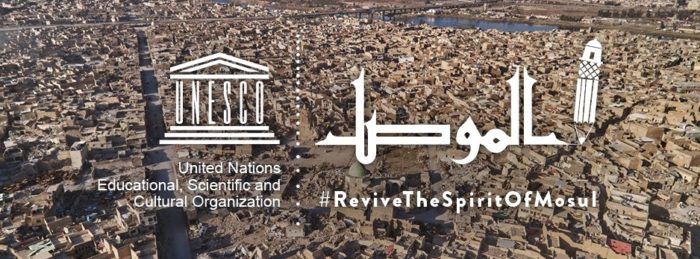Mosul is the living symbol of Iraqi’s pluralistic identity. For centuries, it has been a crossroad of culture in the Middle East. From the Sumerian cities to Babylon, from the walls of Nineveh to the Silk Road, the region has been a melting pot of people and ideas. Between 2014 and 2017, this story of peace – the true spirit of Mosul – has been overshadowed by another story of hatred and violence.
The occupation of Mosul left the City destroyed. Not a single structure is unscathed. Not a single pane of glass is unbroken. The archeological site of Nimrud, the Museum of Mosul, the Nabi Younnis Shrine, the Al Hadba Minaret and many other sites and landmarks lie in ruins.
Thousands of homes are heaps of rubble. Many residents are slowly returning, the camps near the City are full. The entire education sector from pre-primary to higher education is devastated while students and teachers are struggling with the physical as well as the physiological sequels of the war. The occupation of Mosul left the City destroyed. Not a single structure is unscathed. Not a single pane of glass is unbroken. The archeological site of Nimrud, the Museum of Mosul, the Nabi Younnis Shrine, the Al Hadba Minaret and many other sites and landmarks lie in ruins. Thousands of homes are heaps of rubble. Many residents are slowly returning, the camps near the City are full. The entire education sector from pre-primary to higher education is devastated while students and teachers are struggling with the physical as well as the physiological sequels of the war.
In February 2018, the International Conference on the Reconstruction of Iraq (Kuwait City) focused on the importance of the human dimension at the heart of sustainable recovery and reconstruction. This is why the Director-General of UNESCO launched a flagship initiative “Revive the Spirit of Mosul”, focusing on the human dimension of reconstruction. With the full support of the Government of Iraq and of the UN Secretary-General, UNESCO will coordinate international efforts in two main areas: the restoration and rehabilitation of cultural heritage and the revival of educational and cultural institutions.
UNESCO has a longstanding cooperation with Iraq. It has been present in Iraq since early 2003 and has successfully accomplished a number of major cultural heritage projects, such as the restoration of the Al-Askari Shrine in Samarra, and the Revitalization of Erbil Citadel. In 2017, UNESCO, in cooperation with the Iraqi Ministry of Culture, launched the Response Plan for the Safeguarding of Cultural Heritage in the Liberated Areas of Iraq (2017-2019). Revive the Spirit of Mosul” is a UNESCO priority for the next years. It is the most important reconstruction campaign undertaken by UNESCO in recent times. Since February, UNESCO is fully mobilized for the Mosul initiative, at its Headquarter and in its Field Offices in Bagdad and the region. The initiative is in line with the Plan for “Reconstruction and Development in Iraq” of the Iraqi Government and the Program for Recovery and Resilience in Iraq (RRP) initiated by the UN Secretary-General. Follow #ReviveTheSpiritOfMosul.
Original source:
